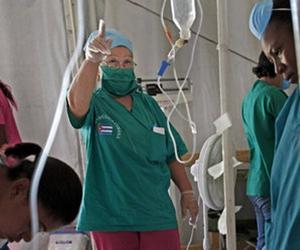Cuba’s top epidemiologist tells CNN in Manzanillo that cholera has not spread
- Submitted by: lena campos
- Health and Medicine
- 07 / 14 / 2012

Cuba’s national director of epidemiology has told a CNN crew, the first foreign journalists to visit the focus of a cholera outbreak, that the disease has not spread to other regions and that the government has not lied about the number of cases.
In Granma, provincial health officials repeated Thursday night that the outbreak was under control and said the number of people hospitalized with cholera-like symptoms dropped from 81 on Wednesday to 67 on Thursday.
Confirmed cholera cases in the same period rose from 118 to 126 — 96 of them in the Granma city of Manzanillo — because it takes laboratories a week or more to confirm the diagnosis, according to the officials.
They also urged residents to continue avoiding unnecessary travel out of the region and repeated instructions for purifying water and hand washing.
Although the provincial officials have appeared on local television nightly since Saturday to inform residents about the epidemic, the government in Havana has issued only one statement, on July 3, confirming three cholera deaths.
“We can categorically say that there is no other outbreak in any other province,” Dr. Manuel Santin Peña, national director of epidemiology, told CNN. The few cases outside Granma were people who had been in the province, he added, giving no further details.
The CNN report noted that “Cuban health officials allowed a CNN crew to be the first media to film in a hospital” in Manzanillo “and speak with doctors there about the ongoing effort to control the cholera outbreak.”
No other foreign journalists in Havana are known to have travelled to Granma since dissidents first reported the outbreak in late June. The government has expelled journalists whose reports displeased it.
The CNN report said doctors at the Celia Sánchez Manduley Hospital in Manzanillo initially believed the outbreak of diarrhea and vomiting was due to food poisoning because the first cases in mid-June attended the same birthday party.
But then people who were not at the party began arriving at the hospital, sometimes 30 in a single day, hospital director Julio Cesar Fonseca Rivera told CNN. Manzanillo residents now refer to the cholera outbreak simply as el evento — the event.
Buckets of bleach sit at the entrances to hospitals and official buildings for people to dip their hands and the soles of their shoes, CNN reported. Authorities shut down kiosks that sell food made with water, and banned fishing and swimming in local waters.
Cuban authorities have not yet commented on the variant of the cholera bacteria that caused the outbreak. A 2010 cholera epidemic killed more than 7,000 people in Haiti, where several hundred Cuban medical personnel have been working for years.
Canada’s Public Health Department and the European Centre for Disease Prevention and Control on Thursday issued cautions to travelers heading to Cuba, advising them to take precautions eating and drinking and wash their hands frequently.
Cuba’s government blocked any public word of the first outbreak of dengue fever in 1976 for several months. Scientists believe it was brought to the island by Cuban soldiers returning from Africa, but Fidel Castro blamed the U.S. Central Intelligence Agency.
Government officials also covered up for almost a year the outbreak of optical neuropathy, which can blind victims, that hit more than 30,000 people 1992-1993. The disease was caused by the malnutrition unleashed when Moscow ended its subsidies to the island, but Havana claimed it was caused more by excessive smoking and drinking.
Source: Miami Herald
Comments